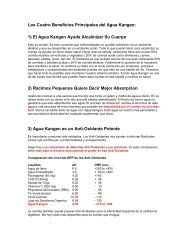ACID-ALKALINE BALANCE: ROLE IN CHRONIC ... - My Kangen Tools
ACID-ALKALINE BALANCE: ROLE IN CHRONIC ... - My Kangen Tools
ACID-ALKALINE BALANCE: ROLE IN CHRONIC ... - My Kangen Tools
Create successful ePaper yourself
Turn your PDF publications into a flip-book with our unique Google optimized e-Paper software.
THOUGHTS AND PROGRESS<br />
985<br />
Japan as a topical disinfectant (1,2). We describe<br />
here our findings that some types of electrolyzed<br />
water appear to accelerate the healing of fullthickness<br />
cutaneous wounds in rats.<br />
Materials and methods<br />
Six different types of water were made and tested.<br />
The first, ultrapure water (resistivity 18 M cm),<br />
was produced by a sequence of treatments applied to<br />
city tap water: charcoal filtration, reverse osmosis,<br />
and ion exchange. One group of experimental animals<br />
was treated with this ultrapure, nonelectrolyzed<br />
water. Four types of electrolyzed water were made<br />
from this ultrapure water. In each case, the water<br />
was electrolyzed (voltage gradient 13 V and apparent<br />
current density 200 mA/cm 2 ) while being<br />
pumped (500 ml/min) through a 3 chamber device<br />
(Coherent Technology, Tokyo, Japan) (3). One<br />
chamber contained a platinum-plated titanium anode.<br />
Usually, the middle chamber was filled with a<br />
saturated sodium chloride solution made with the<br />
ultrapure water. The third chamber contained the<br />
cathode, also made of platinum-coated titanium.<br />
Proprietary ion-exchange membranes separated the<br />
chambers. The following 3 types of electrolyzed water<br />
were made using the Coherent Technology device<br />
in this configuration (all measurements made at<br />
25°C). The first, acid pH water, Ac(+), was taken<br />
from the anode chamber [pH 2.50–2.63, oxidationreduction<br />
potential (ORP) 1104–1191 mV, concentration<br />
of residual chlorine (determined by the<br />
o-toluidine method) 80 to 100 ppm]. Neutral pH<br />
(7.40) anode chamber water, N(+), was made by<br />
adding NaOH (1N) to the electrolyzed water taken<br />
from the anode chamber [pH 7.4, ORP 749–784 mV,<br />
concentration of residual chlorine almost the same<br />
as in the Ac(+) solution]. Alkaline pH water, Al(−),<br />
was taken from the cathode chamber (pH 10.65–<br />
10.85, ORP 212–297 mV, residual chlorine only a few<br />
ppm). Replacing the platinum cathode in the Coherent<br />
Technology device by one made of carbon and<br />
replacing the center-chamber solution by 5 M citrate<br />
(organic acid; citric acid) in ultrapure water allowed<br />
us to make a fourth type of electrolyzed water. This<br />
acidic water [Ac(−)] was taken from the cathode<br />
chamber (pH 3.86–3.87, ORP 212–297 mV, no residual<br />
chlorine). Finally, hypochlorous acid (HOCl)<br />
solution was made by electrolyzing 0.45% NaCl in a<br />
single-chamber device (Omuko Co. Ltd., Tokyo, Japan)<br />
(Voltage gradient, apparent current density,<br />
and pump rate were the same as for the Coherent<br />
Technology device.). The pH and ORP of this solution<br />
were 7.45 and 780 mV, respectively. When<br />
stored in PET bottles, the pH and ORP of all 6 types<br />
of water remained stable for at least a month.<br />
Forty-two Wistar rats (8 weeks old) were randomly<br />
assigned to 6 experimental groups, housed in<br />
individual metabolic cages at 25°C, and fed rodent<br />
chow and water ad libitum. Under pentobarbital anesthesia,<br />
the back was shaved and two 1.0 cm square,<br />
full-thickness cutaneous wounds were made, one behind<br />
the other and 1.5 cm apart, on the back of each<br />
animal. In each rat, 1 wound (selected randomly)<br />
was treated twice a day for 7 days with 1 of the 6<br />
types of water described previously; the other wound<br />
was left untreated. The rat was observed carefully<br />
until the water was absorbed by the wound to ensure<br />
that no spillage occurred. The first treatment was<br />
administered immediately after surgery. All wounds<br />
were allowed to heal without dressings. For 17 days<br />
after surgery, wound areas were measured daily by<br />
planimetry, using digital video camera images displayed<br />
via a personal computer.<br />
Acid and neutralized anode waters were studied<br />
by electron spin resonance (ESR; JEOL-JES-RE2X;<br />
Nihon Denshi, Tokyo, Japan) with the addition of a<br />
spin trapping agent [5,5-dimethyl-1-pyrroline-Noxide<br />
(DMPO, Sigma, St. Louis, MO, U.S.A.)] using<br />
a flat cell of 1 mm width (4). This was carried out 24<br />
hr after the preparation of the electrolyzed water.<br />
The duration of the incubation of the electrolyzed<br />
water with DMPO was 2 min. The magnetic field was<br />
of 335 ± 5 mT. Signal strength was compared with<br />
the signal derived from Mn 2+ (as a control).<br />
All protocols were approved by the Animal Research<br />
Review Committee of Teikyo University<br />
Medical School.<br />
For each group, the results are presented as mean<br />
wound area ± SD. The comparison between the areas<br />
of water-treated and nontreated wounds was<br />
performed using a paired Student’s t test. The comparisons<br />
among the experimental groups were made<br />
using a one-way analysis of variance. When statistical<br />
significant was detected, Dunnett’s test was used<br />
to determine which values differed significantly from<br />
those obtained using the nonelectrolyzed ultrapure<br />
water. Values of p < 0.05 were considered significant.<br />
Results<br />
As shown in Table 1, both types of anode chamber<br />
water [acidic and neutral: Ac(+) and N(+), respectively]<br />
accelerated wound healing (when compared<br />
to the effect of nonelectrolyzed ultrapure water) (p <<br />
0.05). This acceleration of wound healing was evident<br />
from as early as postoperative Day (POD) 1 in<br />
Ac(+) or POD 2 in N(+). The alkaline water from<br />
the cathode chamber [Al(−)] showed a slight, but<br />
Artif Organs, Vol. 24, No. 12, 2000



